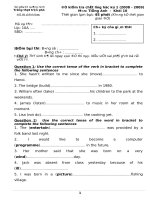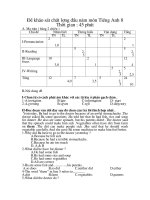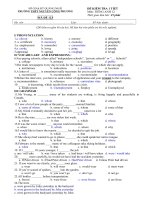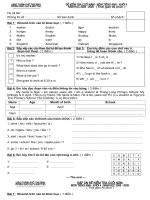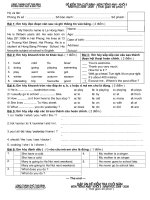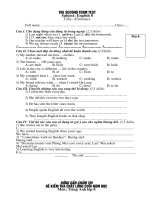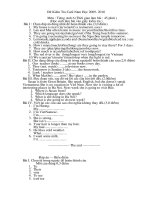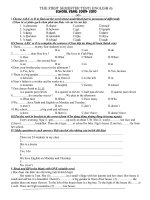Đề + Đáp án Tiếng Anh 2018-2019
Bạn đang xem bản rút gọn của tài liệu. Xem và tải ngay bản đầy đủ của tài liệu tại đây (551.72 KB, 10 trang )
<span class='text_page_counter'>(1)</span><div class='page_container' data-page=1>
Trang 01/08
<b>SỞ GD&ĐT LONG AN </b>
---
<b> ĐỀ CHÍNH THỨC </b>
(Đề thi gồm 08 trang)
<b> KỲ THI TUYỂN SINH LỚP 10 NĂM HỌC 2018 – 2019 </b>
<b> Môn thi: TIẾNG ANH (Chuyên) </b>
<i><b> Thời gian làm bài: 120 phút (khơng kể thời gian phát đề) </b></i>
<i><b>Thí sinh làm bài trên PHIẾU TRẢ LỜI, không làm bài trên đề thi này. </b></i>
---
<i><b>I. LISTENING (2.0 points) </b></i>
<b>PART 1. Questions 1 – 5 </b>
<i><b>You will hear Peter Walsh being interviewed for a job. Listen and choose the correct </b></i>
<i><b>answer for each question. (1.0 point) </b></i>
1. How long has he been in his present job?
A. since 2005
B. for about three years
C. for three months
2. Why does he want a new job?
A. for a change
B. to earn more money
C. to get promotion
3. What does he like most about his job?
A. the right to take action and make decisions
B. his colleagues
C. working conditions
4. What kind of person are they looking for?
A. someone prepared to work overtime
B. someone who is punctual
C. someone who wants to get on
5. What qualifications does Peter have?
A. a degree
B. a school leaving certificate
C. a postgraduate diploma
<b>PART 2. Questions 6 – 10 </b>
<i><b>You will hear an interview with a representative of a wildlife park called Paradise </b></i>
<i><b>Wildlife Park. For questions 6 to 10, complete the sentences. Write only ONE word in </b></i>
<i><b>each gap. (1.0 point) </b></i>
<b>PARADISE WILDLIFE PARK </b>
<i><b>- Project Life Lion is connected with diseases spread by (6) ___________dogs in Africa. </b></i>
<i><b>- The Park has created its own environmental (7) _____________________ system, and </b></i>
other organizations use it.
</div>
<span class='text_page_counter'>(2)</span><div class='page_container' data-page=2>
Trang 02/08
<i><b>II. READING (2.0 points) </b></i>
<i><b>PART 1. You are going to read a newspaper article about careers advice. For questions </b></i>
<i><b>1 – 5, choose the answer A, B, C or D which you think fits best according to the text. </b></i>
<i>(1.0 point) </i>
<b>FINDING THE CAREER THAT FITS YOUR PERSONALITY </b>
“If you’ve finished your exams and have absolutely no idea what to do next, you’re
not alone,” says Sheridan Hughes, an occupational psychologist at Career Analysts, a
career counselling service. “At 18, it can be very difficult to know what you want to do
because you don’t really know what you’re interested in.” Careers guidance, adds Alexis
Hallam, one of her colleagues, is generally poor and “people can end up in the wrong job
and stay there for years because they’re good at something without actually enjoying it.”
To discover what people are good at, and more fundamentally, what they will enjoy
doing, Career Analysts give their clients a battery or personality profile questionnaires and
psychometric tests. An in-depth interview follows, in which the test results are discussed
and different career paths and options are explored with the aid of an occupational
psychologist. Career Analysts offers guidance to everyone, from teenagers to retirees
looking for a new focus in life. The service sounded just what I needed. Dividing my time
as I do between teaching and freelance journalism, I definitely need advice about
consolidating my career. Being too ancient for Career Analysts’ student career option
guidance and not, unfortunately, at the executive level yet, I opted for the career
management package. This is aimed at people who are established in their jobs and who
either want a change or some advice about planning the next step in their careers.
Having filled in a multitude of personality indicator questionnaires at home, I then
spent a rather gruelling morning being aptitude-tested at Career Analysts’ offices. The
tests consisted of logical reasoning followed by verbal, mechanical and spatial aptitude
papers. Logical reasoning required me to pick out the next shape in a sequence of
triangles, squares and oblongs. I tried my best but knew that it was really a lost cause. I
fared rather better when it came to verbal aptitude – finding the odd one out in a series of
words couldn’t be simpler. My complacency was short-lived, however, when I was
confronted with images of levers and pulleys for the mechanical aptitude papers. My mind
went blank. I had no idea what would happen to wheel X when string Y was pulled.
At home, filling in questionnaires, I had been asked to give my instinctive reaction
(not an over-considered one) to statements like: “It bothers me if people think I’m being
odd or unconventional”, or “I like to do my planning alone without interruptions from
others.” I was asked to agree or disagree on a scale of one to five with “I often take on
impossible odds”, or “It is impossible for me to believe that chance or luck plays an
important role in my life.” I was told to indicate how important I consider status to be in a
job, and how important money and material benefits.
The questions attempt to construct a picture of the complete individual. Using
aptitude test alongside personality profiling, occupational psychologists will, the theory
goes, be able to guide a client towards a rewarding, fulfilling career. Some questions are
as straightforward as indicating whether or not you would enjoy a particular job.
Designing aircraft runways? Preparing legal documents? Playing a musical instrument?
Every career going makes an appearance and, as I was shown later, the responses tend to
form a coherent pattern.
</div>
<span class='text_page_counter'>(3)</span><div class='page_container' data-page=3>
Trang 03/08
“What we do works because it’s a mixture of science and counselling. We use objective
psychometric measures to discover our clients’ natural strengths and abilities and then we
talk to them about what they want from life.”
There were no real surprises in my own test results, nor in the interview that
followed it. “We’re interested in patterns,” Mrs. Hughes explained, “and the pattern for
you is strongly verbal and communicative.” This was putting it rather kindly. I had come
out as average on the verbal skills test and below average in logic, numerical, perceptual
and mechanical reasoning. My spatial visualization was so bad that it was almost off the
scale. “A career is cartography, navigation, tiling or architecture would not be playing to
your strengths,” she said delicately.
Mrs. Hughes encouraged me to expand the writing side of my career and gave me
straightforward, practical suggestions as to how I could go about it. “Widen the scope of
your articles,” she said. “You could develop an interest in medical and psychological
fields.” These latter, she said, would sit comfortably with an interest in human behavior
indicated on my personality-profiling questionnaires. She suggested that I consider writing
e-learning content for on-line courses, an avenue that would never have occurred to me.
1. What does the writer say about Career Analysts in the second paragraph?
A. It is about to offer a service for people at executive level.
B. The range of services it offers is unique.
C. She was initially doubtful that it could be useful to her.
D. Only one of its services was relevant to her.
2. What happened when the writer took the aptitude tests?
A. She found two of the papers extremely difficult.
B. She put in very little effort on any of them.
C. She didn’t understand what she was required to do on one of them.
D. The papers were not what she had been expecting.
3. What does the writer say about the statements on the questionnaires?
A. She thought about them for longer than she was supposed to.
B. She found some of them rather strange.
C. One of them focused on her attitude to risk.
D. One of them concerned her current situation only.
4. The writer says that the idea behind the questionnaires is that_____.
A. people will find some of the questions quite hard to answer
B. the answers to them and the aptitude tests will provide all the necessary information
C. they will encourage people to have new ideas about possible careers
D. they will give a more accurate picture of people than the aptitude tests
5. The writer felt that during the interview, Mrs. Hughes_____.
</div>
<span class='text_page_counter'>(4)</span><div class='page_container' data-page=4>
Trang 04/08
<i><b>PART 2. You are going to read the introduction to a guidebook about Yosemite </b></i>
<i><b>National Park in the US. Six sentences have been removed from the article. Choose </b></i>
<i><b>from the sentences A – G the one which fits each gap 6 – 10. There is ONE extra </b></i>
<i><b>sentence which you do not need to use. There is ONE example at the beginning (0). (1.0 </b></i>
<i>point) </i>
<b>YOSEMITE NATIONAL PARK </b>
WHAT exactly is Yosemite? Is it Bridalveil Fall thundering and pouring in early
June? Is it a long summer’s day at Hiolumne Meadows? Is it the ice-carved, rocky world
<i><b>of the high Sierra seen from Glacier Point? (0) ___</b></i>
<b>G</b>
____. It is an energetic walk over theFour Mile Trail. It is the smell of pine trees at Hogdon Meadow campground. It might also
be a walk among some of the largest trees in the world. Our list could go on and on.
<i><b>(6)______. Roaring waterfalls, falling hundreds of feet, fascinate even the most </b></i>
bored traveler. Shining walls of towering rockface challenge the skills of hundreds of
mountain climbers and capture the eyes and minds of thousands of visitors. Yosemite’s
rushing mountain streams, alpine landscape, forests and all the rest of its natural features
combine to make this national park unique in the opinion of nearly every observer.
<b>Yosemite also shows us how the original native American people lived. These earlier </b>
inhabitants of the region left traces of a lifestyle which depended upon the use of local
plants and animals. Remains of that culture, on display in museums and books, sometimes
seen in the surfaces of rock, recalled mainly in names upon the land, show us people’s
lives which were directly connected to this region.
<i><b>(7)______. From the earliest Spanish explorers who gave names to the general </b></i>
region, to the fur trappers, miners and others who came seeking paths through the Sierra
Nevada or hoping for personal gain, Yosemite displays an exciting past which helps us
understand the present. It is a story filled with characters who were impressed enough to
stay, advertise, exploit and preserve.
Yosemite is also an example of wild America, in contrast to the America outside its
boundaries. Its geologic features are the product of time’s hidden forces, carved out by
glaciers and streams. Its birds and bears delight suburban America. Its buzzing mosquitoes
remind us that we are not in a shopping mall. Its flower-filled meadows and tall forests
remind us of the sheep and loggers who once looked out upon this scene.
<i><b>(8)______. While preserved for all to enjoy, perhaps not everyone can enjoy it at </b></i>
once. Occasionally crowded conditions disturb many first-time visitors. Yosemite Valley
does not seem like the quiet place generally shown in photographs. An ever-increasing,
demanding public raises the question - can any national park be all things to all people?
<i><b> (9)______. Bicycling in Yosemite alley, walking the John Muir Trail, skiing at </b></i>
Badger Pass or sitting quietly beside the Merced River are all possibilities. One can walk
with freedom in the park, allowing closer examination of the natural surroundings.
Alternatively, visitors to Yosemite can take shuttle buses and disembark for short
adventures beyond the roadway or can go into informational museums.
Yosemite is a spectacular Sierra Nevada park. Yosemite is history, geology, Indians,
scenery beyond compare, and conservation. Yosemite is part of America that we always
want to experience and never want to lose. It has become a part of our imagination.
</div>
<span class='text_page_counter'>(5)</span><div class='page_container' data-page=5>
Trang 05/08
<b>A</b>
. Yosemite recalls a history, rich with colorful personalities and filled with dramaticevents.
<b>B</b>
<b>. Because of that, Yosemite is more than a park, it is an ideal. </b><b>C</b>
<b>. Yosemite contains natural features which cannot fail to attract human attention. </b><b>D</b>
<b>. Yosemite is well-known not just to Americans, but to people all over the world. </b><b>E</b>
<b>. For today’s visitors, Yosemite offers a source of pleasure and a choice of activity. </b><b>F</b>
. Yosemite might also be an example of a national park that is too successful, that hasbecome too popular.
<b>G</b>
. Obviously, Yosemite is all of these things and much, much more.<i><b>III. USE OF ENGLISH (4.0 points) </b></i>
<i><b>PART 1. Choose the word or phrase A, B, C or D that best completes each sentence. </b></i>
<i>(0.5point) </i>
1. _____ his assistance in those days, I would not be so successful now.
A. If it had not for B. Had it not been for
C. If there were not D. Unless I had
2. Louise is still in Palma, so you _____ her at the library.
A. couldn’t see B. weren’t able to see
C. mustn’t have seen D. can’t have seen
3. The collapse of tin prices in the 1980s destroyed the tin-mining industry, _____ former
employees have since turned in desperation to growing coca.
A. all of whom B. many of whose C. none of their D. several of its
4. True learning does not _____ in gathering facts from the teachers; it requires active
assimilation of knowledge.
A. achieve B. consist C. depend D. come
5. When the students got _____ the test, he gave it to the teacher.
A. over with B. through with C. through at D. over
6. The recommendation that all people affected by the storm _____ immediately was
approved.
A. must be evacuated B. be evacuated
C. ought to be evacuated D. had to be evacuated
7. Local residents object _____ the new power station in their area.
A. to have B. having C. of having D. to having
8. This fascinating book covers some of the most _____ crimes of the twentieth century.
A. unknown B. hidden C. covered D. infamous
9. Nobody, even the best doctors, expected Frank’s __________ to be so quick and
successful after so severe an accident.
A. renewal B. resumption C. recuperation D. remuneration
10. What _____ make is your car? It is _____ Lexus.
</div>
<span class='text_page_counter'>(6)</span><div class='page_container' data-page=6>
Trang 06/08
<i><b>PART 2. Read the following passage and decide which answer A, B, C or D best fits </b></i>
<i><b>each gap. There is ONE example at the beginning (0). (1.0 point) </b></i>
<b>Peoples’ personalities (0) VARY considerably from one another as there are no </b>
<i><b>two alike. Our ingrained characteristics which (1) _______ the patterns of our behavior, </b></i>
our reactions and temperaments are unparalleled on account of the diversified processes
<i><b>that (2) _______ our personality in the earliest stages of human development. </b></i>
<i><b>Some (3) ________ of character may, to some extent, be hereditary simulating the </b></i>
<i><b>attributes that (4) ________ our parents. Others may (5) ________ from the conditions </b></i>
experienced during pregnancy and infancy in this way reflecting the parents’ approach
<i><b>towards (6) ________ their offspring. Consequently, the environmental factor plays a </b></i>
crucial role in strengthening or eliminating certain behavioral systems making an
<i><b>individual more prone to (7) ________ to the patterns that (8) ________ a prize. </b></i>
<i><b>Undoubtedly, human personality (9) ________ the most profound and irreversible </b></i>
formation during the first period of its development, yet, certain characteristics may still
<i><b>be (10) ________ to considerable changes conditioned by different circumstances and </b></i>
situations.
<b>0. A. distinguish </b> <b>B. vary </b> C. converge D. differentiate
1. A. denote B. resolve C. inflict D. determine
2. A. mould B. design C. conceive D. fabricate
3. A. factors B. traits C. items D. breeds
4. A. pertain B. recognize C. associate D. identify
5. A. stem B. relate C. rise D. formulate
6. A. breeding B. rearing C. growing D. yielding
7. A. comfort B. pledge C. acquiesce D. obey
8. A. yearn B. deserve C. wish D. necessitate
9. A. underacts B. undertakes C. undergoes D. underlies
10. A. practicable B. feasible C. subject D. potential
<i><b>PART 3. Fill each blank with ONE suitable word. (1.0 point) </b></i>
<b>YURI GAGARIN </b>
</div>
<span class='text_page_counter'>(7)</span><div class='page_container' data-page=7>
Trang 07/08
<i><b>PART 4. Give the correct form of the words in the brackets. (1.0 point) </b></i>
<b>Example: (0) EXCAVATION </b>
<b>THE WORLD’S OLDEST PERFUME </b>
<i><b>Archaeologists working at an (0. excavate) EXCAVATION on the island of </b></i>
Cyprus have discovered what are thought to be the world’s oldest known perfumes.
<i><b>Remnants of fourteen different fragrances were found in a (1. select) __________ of </b></i>
<i><b>mixing jugs, bottles and stills which were (2. earth) __________ on the site of an ancient </b></i>
perfumery. The building was destroyed by an earthquake nearly four thousand years ago,
<i><b>at a time when Cyprus already enjoyed a (3. reputed) __________ as a centre of </b></i>
perfume-making.
<i><b>After undergoing scientific (4. analyse) __________, the perfumes were found to </b></i>
<i><b>contain a range of (5. local) __________ available ingredients, such as extracts of anise, </b></i>
pine, coriander, lemon, orange, bergamot, almond and parsley, amongst others.
<i><b>Having (6. identify) __________ what each perfume contained, the scientists then </b></i>
<i><b>set about remaking them using (7. tradition) __________ techniques to find out what they </b></i>
<i><b>would actually have smelt like. They first (8. grind) __________ up the extracts, then </b></i>
mixed them with olive oil in clay jugs before distilling them. This method is the one
<i><b>recorded by writers in Ancient Roman times. Although (9. admit) __________ simple by </b></i>
today’s standards, the resulting aromas provide us with an olfactory window onto the
ancient world, and are evidence of the loving craftsmanship that must have been applied
<i><b>by their (10. create) __________. </b></i>
<i><b>PART 5 </b></i>
<i><b>For questions 1 – 5, complete the second sentence so that it has a similar meaning to the </b></i>
<i><b>first sentence, using the word given. Do NOT change the word given. You must use </b></i>
<i><b>between THREE and SIX words, including the word given. (0.25 point) </b></i>
Example:
0. Milly burst out laughing when she saw herself in the mirror. <b>SIGHT </b>
<i>→ Milly burst into _______________________________________ herself in the mirror. </i>
<b>Example: 0. LAUGHTER WHEN SHE CAUGHT SIGHT OF </b>
</div>
<span class='text_page_counter'>(8)</span><div class='page_container' data-page=8>
Trang 08/08
<i><b>For questions 6 – 10, finish each of the sentences in such a way that it means exactly </b></i>
<i><b>the same as the one printed before it. (0.25 point) </b></i>
6. The price of the room includes breakfast.
<i>→ Breakfast _____________________________________________________________ . </i>
7. The psychiatrist asked her what she had dreamt about the night before.
<i>→ “What ___________________________________________?”, asked the psychiatrist. </i>
8. I’d appreciate if you were a bit quieter.
<i>→ Could you try ______________________________________________ noise, please? </i>
9. We were surprised to learn that Brian had become a monk.
<i>→ It came ______________________________________________________________. </i>
10. If anyone succeeds in solving the problem, it will probably be him.
<i>→ He is the most _________________________________________________________. </i>
<i><b>IV. WRITING (2.0 points) </b></i>
<i><b>In about 130 – 150 words, write a PARAGRAPH answering the following question. </b></i>
<i><b>“Why do you want to major in English at Long An High School for the Gifted?” </b></i>
Use specific reasons and details to support your answer.
<b>---HẾT--- </b>
<i>Cán bộ coi thi không giải thích gì thêm </i>
</div>
<span class='text_page_counter'>(9)</span><div class='page_container' data-page=9>
Trang 01/02
<b>SỞ GD&ĐT LONG AN </b>
<b> --- </b>
<b> ĐỀ CHÍNH THỨC </b>
<b>KỲ THI TUYỂN SINH VÀO LỚP 10 </b>
<b>NĂM HỌC 2018 – 2019 </b>
<b>HƯỚNG DẪN CHẤM ĐỀ CHÍNH THỨC </b>
<b>Mơn thi: TIẾNG ANH (Chun) </b>
<i>(Hướng dẫn chấm gồm 02 trang) </i>
<i><b>I. LISTENING (2.0 points / 0.2 each) </b></i>
1. B 2. C 3. A 4. A 5. A
6. domestic 7. management 8. corporate 9. prizes 10. presenter
<i><b>II. READING (2.0 points / 0.2 each) </b></i>
1. D 2. A 3. C 4. B 5. A
6. C 7. A 8. F 9. E 10. B
<i><b>III. USE OF ENGLISH (4.0 points) </b></i>
<i><b>PART 1 (0.5 point / 0.05 each) </b></i>
1. B 2. D 3. B 4. B 5. B
6. B 7. D 8. D 9. C 10. C
<i><b>PART 2 (1.0 point / 0.1 each) </b></i>
1. D 2. A 3. B 4. D 5. A
6. B 7. A 8. B 9. C 10. C
<i><b>PART 3 (1.0 point / 0.1 each) </b></i>
1. of 2. in 3. as 4. was 5. before/previously
6. by 7. which 8. the 9. not 10. spend
<i><b>PART 4 (1.0 point / 0.1 each) </b></i>
1. selection 6. identified
2. unearthed 7. traditional
3. repute / reputation 8. ground
4. analysis 9. admittedly
</div>
<span class='text_page_counter'>(10)</span><div class='page_container' data-page=10>
Trang 02/02
<i><b>PART 5 (0.5 point / 0.05 each) </b></i>
<i><b>1. They gave a description of the robber on the evening news. </b></i>
<i><b>2. I made my mum a promise that I would work hard this year. </b></i>
<i><b>3. I am getting used to learning Chinese. </b></i>
<i><b>4. I’d rather read books than play with computers. </b></i>
<i><b>5. I flicked / looked through the magazine in the dentist’s waiting room. </b></i>
<i><b>6. Breakfast is included in the price of the room. </b></i>
<i><b>7. “What did you dream (about) last night?”, asked the psychiatrist. </b></i>
<i><b>8. Could you try to make less noise, please? </b></i>
<i><b>9. It came as a surprise to us that Brian had become a monk. </b></i>
<i><b>10. He is the most likely person to succeed in solving the problem. </b></i>
<i><b>IV. WRITING (2.0 points) </b></i>
Answers vary.
<i><b>Notes </b></i>
<i>The mark given to this part is based on the following criteria. </i>
<b>Criteria </b> <b>Descriptors </b> <b>Marks </b>
1. Content 1.0
- Covering all points (0.5p)
- Meeting length requirements (0.1p)
- Development of ideas (0.4p)
2. Organization and Cohesion 0.2
- Linking devices (0.1p)
<i>- Mechanics (punctuation) (0.1p) </i>
3. Structures and Vocabulary 0.6
- Range of vocabulary (0.2p)
- Appropriacy of vocabulary (0.1p)
- Range of structures (0.2p)
- Accuracy of grammar (0.1p)
4. Register and Style 0.2
- Adequacy of vocabulary (0.1p)
- Adequacy of structures (0.1p)
Total <b>2.0 </b>
</div>
<!--links-->
